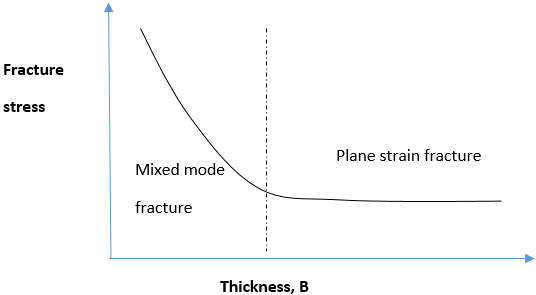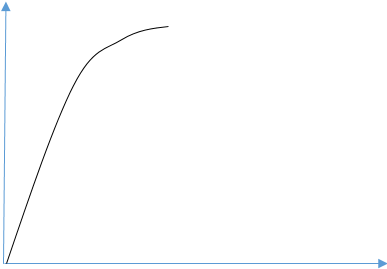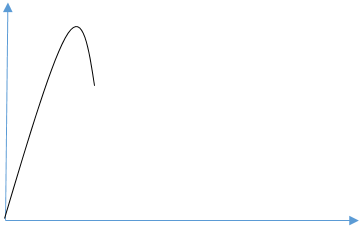This set of Mechanical Metallurgy Multiple Choice Questions & Answers (MCQs) focuses on “Fracture Mechanics – Fracture Toughness and Design”.
1. The stress intensity for a plate is given as K=σ√(πa) tan(πta); where a is crack length equal to 6 mm, t is the thickness of the plate equal to 1 cm, and σ is the nominal stress applied. Determine the maximum allowable stress if KIc=50 MPa m-1/2.
a) 100 MPa
b) 145 MPa
c) 200 MPa
d) 500 MPa
View Answer
Explanation: The stress intensity factor is given as:
K=σ√(πa)tan (πta)
So K= 50 MPa m-1/2, a= 5*10-3 m, t=1*10-2 m
Substitute the values in the equation: 50= σ √(3.14*5*10-3) tan(3.14*1*10-2*5*10-3)
50=σ*2.74*10-6*0.125
σ=147.058*106
σ=147.058 MPa
So the allowable stress from the options will be equal to 145 MPa.
2. The value of KIc ____________ with increase in the temperature and __________ with increase in the strain rate.
a) increases, decreases
b) increases, Increases
c) decreases, decreases
d) increases, Increases
View Answer
Explanation: The fracture toughness is the material property which changes with temperature and decreases with a decrease in the temperature and increases with decrease in strain rate.
3. The KIC is independent of heat treatment, texture, melting practice, impurities, and inclusion, etc.
a) True
b) False
View Answer
Explanation: The fracture toughness values depends upon the heat treatment, metallurgical conditions, and texture, etc. because it is an inherent material property which changes with the composition of the material.
4. The notch in the thick plate is far more damaging than the groove in a thin plate because of the _________
a) plane-stress
b) plane-strain
c) triaxle state of stress
d) uniaxial state of stress
View Answer
Explanation: The Notch in the Thick plate creates a region of plane strain with a state of the high degree of triaxiality.

5. The minimum thickness of the material to achieve the condition of plane strain is given by ______
a) B=2.5 (KIC/σo)
b) B=2.5 (KIC/σo)2
c) B=2.5 (KIC/σo)1/2
d) B=2.5 (KIC/σo)-1/2
View Answer
Explanation: As the thickness of the material increases, the crack shifts from mixed ductile-brittle mode to the pure brittle fracture mode. The condition of 100% brittle failure mode is known as the plane strain condition. So the minimum thickness to achieve the state of plane strain is given by:
B=2.5 (KIC/σo)2
6. The fracture toughness of the material is given as 25 MPa m1/2, and the yield strength is equal to 600 MPa. Find the minimum thickness of the material to achieve the condition of plane strain?
a) 5 mm
b) 4.3 mm
c) 5 cm
d) 10 mm
View Answer
Explanation: To achieve the condition of plane strain, the equation is given as:
B = 2.5 (KIC/σo)2
B = 2.5 (25/600)2
B = 0.0043
So the minimum thickness to achieve the condition of plane strain is given as 4.3 mm.
7. Load vs. notch displacement curve for very brittle elastic material is given by the following curve.

a) True
b) False
View Answer
Explanation: The very brittle content behaves as the complete “pop-in” method in which there is sudden propagation of notch with decreases in the load.

8. According to Irwin’s correction of plasticity at the crack tip, the sufficient crack length is given as the actual crack length plus the radius of the plastic zone. The radius of the plastic zone (rp) in case of plane stress is given as ________
a) rp=1/2 K2/σo2
b) rp=1/2 K2/πσo2
c) rp=1/2 K2/σo
d) rp=1/2 K/σo
View Answer
Explanation: The radius of the plastic zone is given as the 1/2 K2/πσo2. This radius approximate the size of the plastic zone in front of the crack tip.
9. According to Irwin’s correction of plasticity at the crack tip, the effective crack length is given as the actual crack length plus the radius of the plastic zone. The radius of the plastic zone (rp) in case of plane strain is given as ________
a) rp=1/2 K2/σo2
b) rp=1/6 K2/πσo2
c) rp=1/8 K2/σo
d) rp=1/2 K/σo
View Answer
Explanation: The radius of the plastic zone is given as the 1/6 K2/πσo2. The radius of the plane strain is lower than plane stress; and it is an indication that the triaxle stress field in the plane strain suppresses the extent of the plastic deformation.
10. A copper plate with an initial crack length of 30 mm is subjected to the stress of 500 MPa normal to crack. If the yield strength of the copper is 1000 MPa, Find the plastic zone size? Assume the plate is infinity wide.
a) 1.19 mm
b) 2.1 mm
c) 3.5 mm
d) 10 mm
View Answer
Explanation: Plastic zone size is given as:
\(\frac{1 σ^2 a}{2π σ^2}\)
Substitute the values in the equation: –
1*5002 1012*30*10-3/(2*3.14*10002*1012)
30*10-3/2*3.14*4
1.19*10-3
So the radius of the plastic zone is 1.19 mm.
Sanfoundry Global Education & Learning Series – Mechanical Metallurgy.
To practice all areas of Mechanical Metallurgy, here is complete set of 1000+ Multiple Choice Questions and Answers.
If you find a mistake in question / option / answer, kindly take a screenshot and email to [email protected]
- Check Metallurgical Engineering Books
- Practice Metallurgical Engineering MCQs
- Apply for Metallurgical Engineering Internship
- Check Mechanical Metallurgy Books
